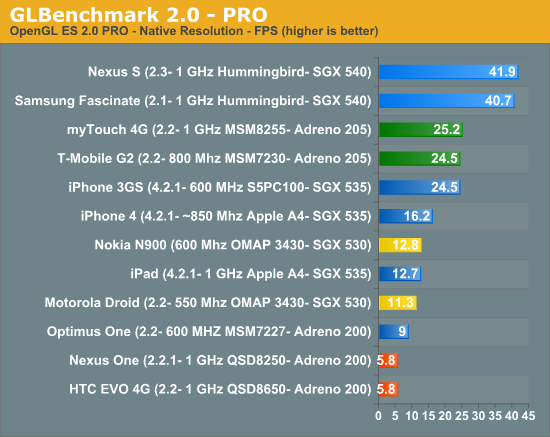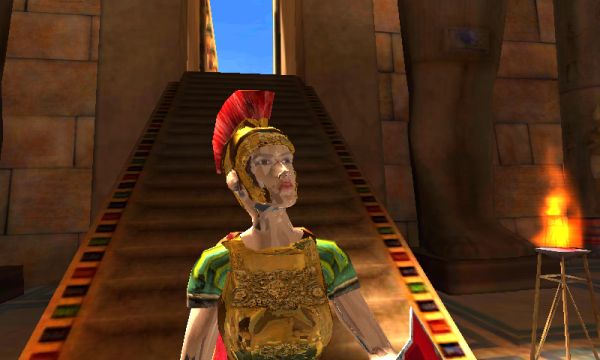GLBenchmark 2.0 Released - Modern SoCs Benchmarked
by Brian Klug on December 17, 2010 2:08 AM EST- Posted in
- Smartphones
- GLBenchmark
- Mobile
- SoCs
We're constantly on the lookout for new benchmarks to use for benchmarking the latest SoCs in devices. Today, Kishonti Informatics released GLBenchmark 2.0, the latest version of its popular GLBenchmark suite for measuring 3D graphics performance across a host of platforms: iOS, Android, Symbian, Windows Mobile, and Maemo. We've been testing it out for a while now and have some numbers of our own and from the community results. The end result is yet another look at how 3D performance stacks up between nearly all modern SoCs.
GLBenchmark 2.0 - as its name implies - tests OpenGL ES 2.0 performance on compatible devices. The suite includes two long benchmarking scenarios with a demanding combination of OpenGL ES 2.0 effects, and individual tests such as swap buffer speed (for determining the framerate cap), texture fill, triangle, and geometric tests. GLBenchmark 2.0 also leverages texture based and direct lighting, bump, environment, and radiance mapping, soft shadows, vertex shader based skinning, level of detail support, multi-pass deferred rendering, noise textures, and ETC1 texture compression.
We've been testing devices for a little while now and have a decent enough spread to make for some interesting comparison. The only extra consideration is that all of these were run at the device's respective native resolution. There's no way to change resolution, and likewise numbers cannot be scaled linearly because we may be memory bandwidth limited on some devices. GLBenchmark will join our benchmark suite for devices going forward.
First are the resolutions (native) of the devices themselves:
| Device Resolutions - GLBenchmark Native Resolution | |||||
| Google Nexus One | 800x480 WVGA | ||||
| LG Optimus One | 320x480 HVGA | ||||
| T-Mobile myTouch 4G | 800x480 WVGA | ||||
| Samsung Fascinate | 800x480 WVGA | ||||
| Google Nexus S | 800x480 WVGA | ||||
| HTC EVO 4G | 800x480 WVGA | ||||
| Apple iPhone 4 | 960x640 DVGA | ||||
| Apple iPad | 1024x768 XGA | ||||
| Motorola Droid | 854x480 FWVGA | ||||
| T-Mobile G2 | 800x480 WVGA | ||||
| Nokia N900 | 800x480 WVGA | ||||
| Apple iPhone 3GS | 320x480 HVGA | ||||
Thankfully, comparison across devices running Android is easy thanks to the relatively standard WVGA resolution guidelines for high end devices.


The first benchmark, Egypt, tests OpenGL ES 2.0 and represents the newest and most demanding benchmark. The second - GLBenchmark PRO - represents a suite that tests OpenGL ES 1.1 performance. (edit: GLBenchmark Pro also tests OpenGL ES 2.0 features, and is a port of an earlier GLBenchmark 1.1 test which focused on OpenGL ES 1.1 performance). Moving forward we will report these whenever possible on smartphone reviews.
It's pretty apparent right now that PowerVR SGX 540 still holds the lead, though the new 45 nm Qualcomms with Adreno 205 are a huge jump forwards from Adreno 200 performance wise. It's interesting that it looks like we're GPU or memory bandwidth bound on those new Qualcomms, as evidenced by the similar results the myTouch 4G and G2 post despite a 200 MHz CPU clock disparity.
Overall, GLBenchmark is designed to showcase some of the OpenGL ES 2.0 features that developers may potentially use in future gaming titles. There are a lot more low level tests which we'll be playing around with in the future and using to test in much more detail.

















64 Comments
View All Comments
warisz00r - Friday, December 17, 2010 - link
The graphics shown on them looks quite... erm... frosted butts?zebrax2 - Friday, December 17, 2010 - link
It looks like to me that they made the characters super shiny but because of the low polygon count of the character themselves it created chunks of colors instead of a nice transition.luigi777 - Friday, December 17, 2010 - link
i have nexus one i didn't experinced the "supershiny" effect. the woman's skin looks much betterB3an - Friday, December 17, 2010 - link
Pretty disappointing graphics for something that's meant to show them off. The textures and modelling are not exactly great quality either.nnkirk - Friday, December 17, 2010 - link
Brian, where is n900 benchmarks ? i read the software suite supports maemo also,..Nnkirk
Brian Klug - Friday, December 17, 2010 - link
Oops, that actually was the N900. I don't know why I put N8, it's because I've been staring at that phone a lot lately. Fixed!-Brian
solnyshok - Friday, December 17, 2010 - link
wrong resolution for Nokia n8.kagenokurei - Friday, December 17, 2010 - link
yup..N8 has 640x360(nHD)..and it definitely doesnt have a 600MHz OMAP..neither a PowerVR SGX..looks like its supposed to be the N900...
i'll be running the test on my N8 now..just to see where it sits w/ its 680MHz ARM core and Broadcom GPU...
kavanoz - Friday, December 17, 2010 - link
My N8 is not able to run some of the tests (ie: Egypt)Brian Klug - Friday, December 17, 2010 - link
That should've been the N900, my mistake!-Brian